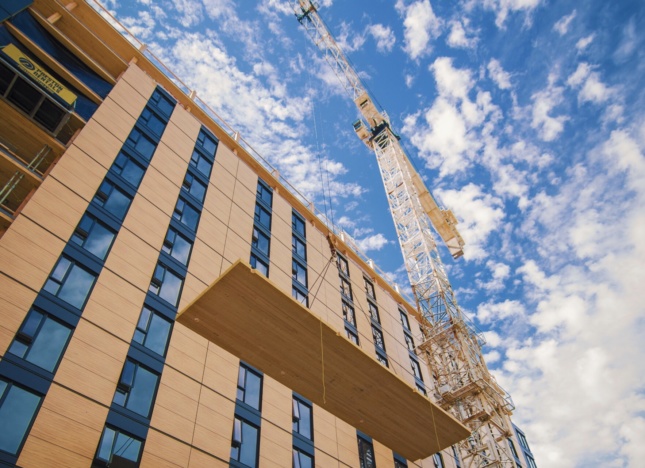If California’s gubernatorial candidates are to fulfill their ambituous goal of adding up to 3.5 million new housing units across the state over the next eight years, new efforts will need to be undertaken to streamline and reform the state’s sagging construction industry—Could this effort create an opening for mass timber construction to take hold in the Golden State?
It might, and here are a few reasons why.
For one, there’s a growing push for new urban housing in California that could soon make the mid-rise apartment the state’s quintessential dwelling type. There’s strong reason to believe that if proposed regulatory changes go as planned, cities in the state could see a flowering of the kinds of four- to eight-story multi-family structures mass timber excels at delivering. With construction times running 15 to 20 percent faster than conventional building, there’s a potential mass timber technologies could help bring new units online very quickly, especially if minimum dwelling standards are set and municipalities streamline permitting and approval.
Secondly, mass timber is becoming more widely-accepted as a building approach, reflecting a growing awareness of its inherent structural and fire-safety benefits. The nascent industry is cheering recent changes to the 2021 version of the International Building Code that will allow mass timber construction for structures up to 18-stories high. The shift could bring down the cost of building dense housing in the medium-sized city centers—downtown Long Beach, Glendale, San Diego, San Jose, and Oakland, for example—where lots of growth could happen but has so far been lacking. At these heights, it’s possible mass timber buildings could be more affordable to build than conventional structures while still delivering the height and structural resilience formerly only possible through concrete and steel frame construction. With San Francisco and L.A. building out larger transit systems and the state’s high-speed trail line on the way, it will be important to add high density nodes throughout the state to meet climate and housing goals.

Cory Scrivner, a mass timber specialist with Structurlam, explained via email that with the coming changes to IBC and looming reforms to local zoning, “The market for mass timber will be growing significantly over the next few years.”
With disruptive and new tariffs on foreign-grown softwood and imported steel and aluminum, its possible there could be further financial incentives to build structures made from regionally-grown timber, as well.
Katerra, a Menlo Park, California-based construction technology and services start-up, is busy constructing a 250,000-square-foot factory in Spokane, Washington where it will produce mass timber products including cross laminated timber (CLT) panels. The company, which seeks to bring many aspects of the construction process—design, engineering, materials, manufacturing, and assembly—under one name while also modernizing the construction trades, is well-poised to play a role in California’s housing recovery. The company—which already has a functioning factory in Arizona—is growing, having just received a boost of $865 million in investment capital as it seeks to build out its network of regional manufacturing facilities
Furthermore, because mass timber manufacturing is typically performed indoors with fewer workers and in advance of job site installation, mass timber construction also potentially holds the promise of side-stepping the state’s vexing shortage of skilled construction workers, one of the many unsolved structural repercussions of the Great Recession.
According to Craig Curtis, president of Katerra’s architecture unit, the company’s factory-focused business model means that fewer—and differently-trained—workers are required on site. Instead of hammering nail to wood on a desolate job site, Katerra’s equipment operators and workers produce interior and exterior wall panels, roof truss assemblies, floor systems and countertops, among other building components in a factory. On-site, a crane and a well-trained team of workers assemble each new building in a fraction of the time compared to normative building practices.
Curtis said over telephone, “[Addressing California’s housing crisis] is exactly the type of problem we are trying to solve—everyone deserves to live in a well-designed home delivered at an affordable price point.”
And lastly, because each mass timber assembly is made to order, the so-called “mass-customization” potential of mass timber construction could also be a boon for the urban character of cities and residents alike, potentially resulting in a rich variety of building approaches and unit types. Might this variable approach even do away with the dreaded “stucco box?” Only time will tell.
California’s housing shortage is a watershed event several generations in the making that will require proportional measures if it is to be adequately addressed. Given current understanding of what the mass timber industry is capable of producing, a rising wave of zoning reform, and growing funding sources for affordable housing construction, it might be time for municipalities and developers alike to take a look at this new building technology.











